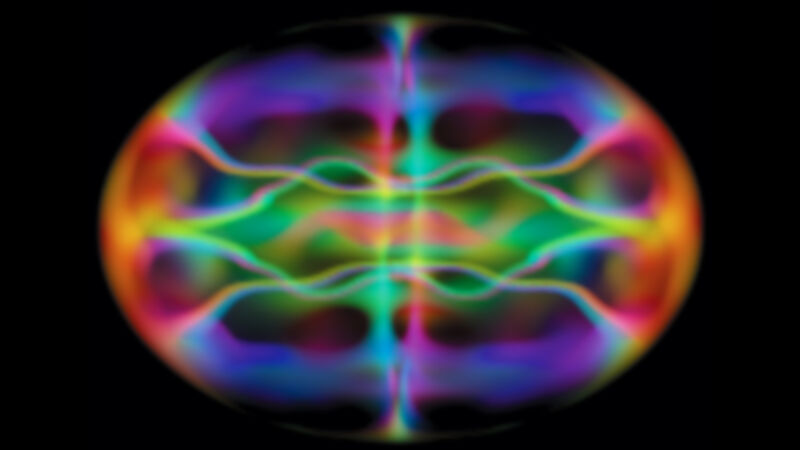The Universe in a lab: Testing alternate cosmology using a cloud of atoms
[ad_1]

In the basement of Kirchhoff-Institut für Physik in Germany, researchers have been simulating the Universe as it might have existed shortly after the Big Bang. They have created a tabletop quantum field simulation that involves using magnets and lasers to control a sample of potassium-39 atoms that is held close to absolute zero. They then use equations to translate the results at this small scale to explore possible features of the early Universe.
The work done so far shows that it’s possible to simulate a Universe with a different curvature. In a positively curved universe, if you travel in any direction in a straight line, you will come back to where you started. In a negatively curved universe, space is bent in a saddle shape. The Universe is currently flat or nearly flat, according to Marius Sparn, a PhD student at Kirchhoff-Institut für Physik. But at the beginning of its existence, it might have been more positively or negatively curved.
Around the curve
“If you have a sphere that’s really huge, like the Earth or something, if you see only a small part of it, you don’t know—is it closed or is it infinitely open?” said Sabine Hossenfelder, member of the Munich Center for Mathematical Philosophy. “It becomes a philosophical question, really. The only things we know come from the part of the Universe we observe. Normally, the way that people phrase it is that, for all we know, the curvature in this part of the Universe is compatible with zero.”
Sparn was one of the authors of a research paper, “Quantum Field Simulator for Dynamics in Curved Spacetime,” which was published in Nature in November 2022. He collaborated with scientists from Belgium, Spain, and Germany. The team studied three possible scenarios for the Universe’s early expansion—constant, accelerated, and decelerated.
The tabletop experiment involved putting the potassium-39 in a glass cell between a set of large magnetic coils above and below it, Sparn said. These magnetic coils, along with some lasers, were used to control the behavior of the sample. The atoms were trapped in a thin layer that can be considered two-dimensional, according to a press statement from Heidelberg University.
When cooled to a temperature of 40 to 60 nanokelvins, Sparn said, the potassium-39 enters a quantum-mechanical state that is known as a Bose-Einstein condensate. Bose-Einstein condensates function as a single megaparticle, according to Ramon Szmuk, product manager at Quantum Machines.
“Our Bose-Einstein condensate is an object that’s completely governed by quantum mechanics because we work at very, very low temperatures,” Sparn said. “The team is then looking for small perturbations of [the] condensate. So you can imagine it as small ripples of density fluctuations. These are governed by quantum mechanics.”
“A single run of our experiment ends with taking a picture, obviously,” Sparn said. “So we shine in light that’s resonant with an atomic transition of potassium-39 and we take absorption images of the cloud. And in this process, we typically destroy our condensate. We see less light where there have been atoms. We can extract the density of atoms from that. So our final result is always an image of the density distribution of our atoms. And from there, we can make statistical analysis to get more information about the results.”
Alternate universes
The scientists fit together equations for the Universe and equations for the Bose-Einstein condensate to draw conclusions about how the early Universe might have behaved.
Sparn said the team simulated positive curvature by increasing the density of the potassium-39 going outward from the center of the experimental setup. They simulated negative curvature by decreasing it.
“We showed that it is possible to simulate spatially curved and expanding spacetimes in a Bose-Einstein condensate,” Sparn said. “This is what you need for a homogeneous and isotropic universe, which should be a fair assumption on large scales.”
During the last few years, scientists have been using quantum atomic systems to find analogies to complex systems in the cosmos, Szmuk said. This connects atomic physics and astrophysics.
Nature, 2023. DOI: 10.1038/s41586-022-05313-9
Kat Friedrich is a former mechanical engineer who started out as an applied mathematics, engineering, and physics major at the University of Wisconsin-Madison. She has completed a graduate degree focusing on science and environmental journalism and has edited seven news publications, two of which she co-founded. She is the editor in chief of the energy magazine Solar Today.
[ad_2]
Read More:The Universe in a lab: Testing alternate cosmology using a cloud of atoms

Comments are closed.